International Management: Market Entry and Cultural Analysis
VerifiedAdded on 2019/10/18
|9
|2402
|243
Report
AI Summary
This report analyzes strategies for entering the international market, specifically focusing on the Southeast Asian region and the Muslim society in Malaysia. The author, acting as a regional manager, evaluates market entry strategies such as direct exporting, considering factors like tariff rates and product acceptance. The report explores various approaches to staff recruitment, including ethnocentric, polycentric, and regiocentric methods, evaluating their advantages and disadvantages. Furthermore, it delves into the Malaysian culture, highlighting its high-context nature and implications for business communication and operations. The report emphasizes the importance of understanding cultural nuances to avoid misunderstandings and ensure successful international ventures. It concludes by suggesting strategies for adapting to the Malaysian cultural context, such as relying on prototypes and using intermediaries to facilitate communication.
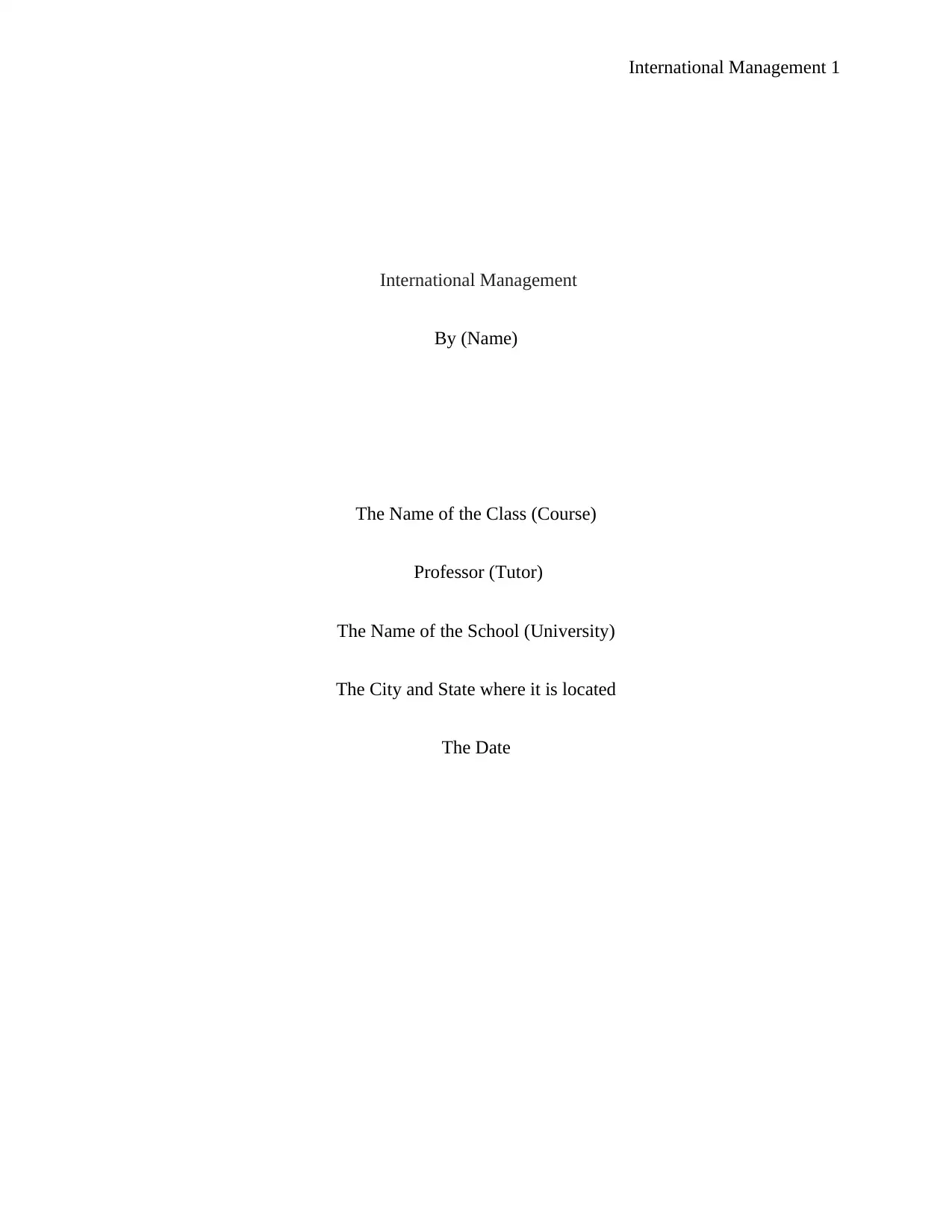
International Management 1
International Management
By (Name)
The Name of the Class (Course)
Professor (Tutor)
The Name of the School (University)
The City and State where it is located
The Date
International Management
By (Name)
The Name of the Class (Course)
Professor (Tutor)
The Name of the School (University)
The City and State where it is located
The Date
Paraphrase This Document
Need a fresh take? Get an instant paraphrase of this document with our AI Paraphraser
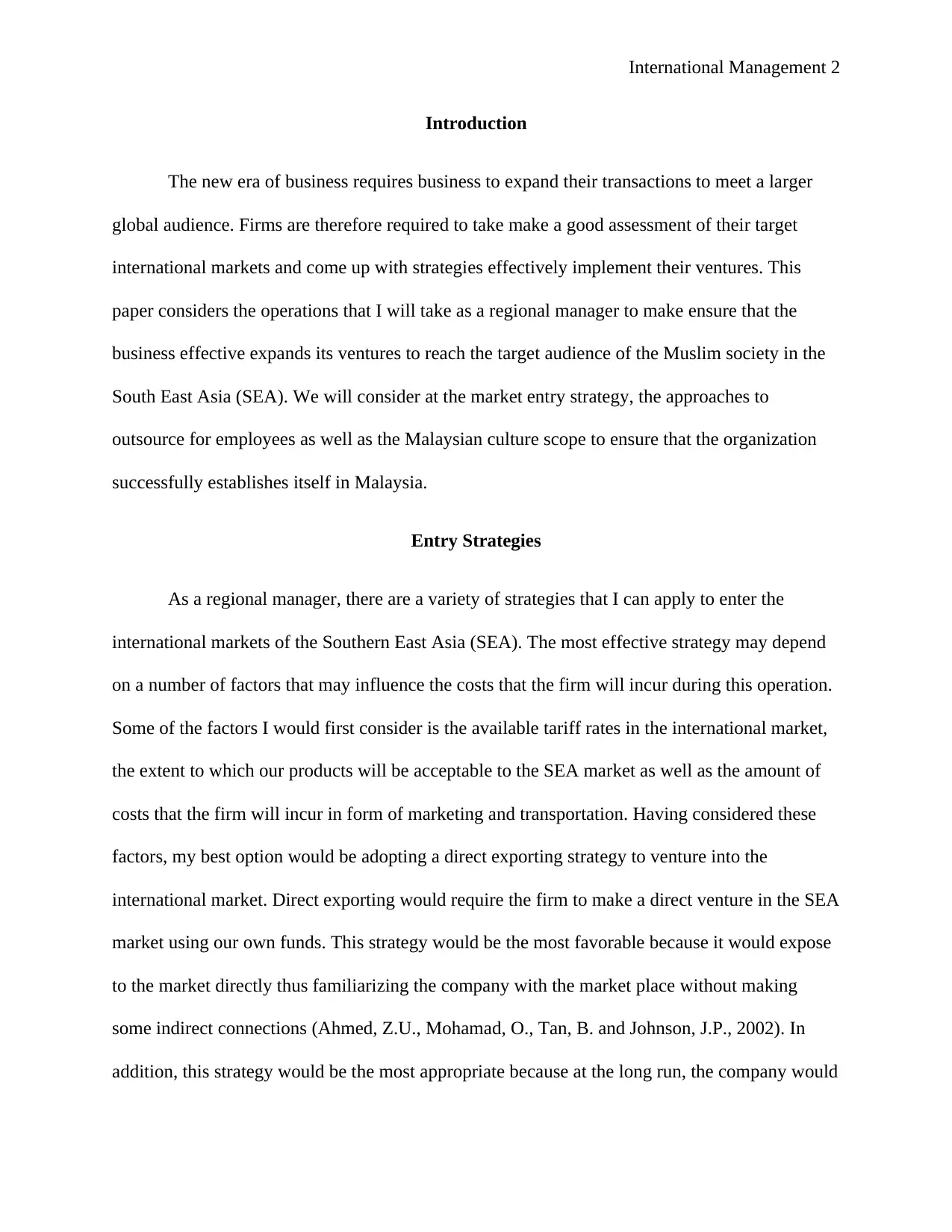
International Management 2
Introduction
The new era of business requires business to expand their transactions to meet a larger
global audience. Firms are therefore required to take make a good assessment of their target
international markets and come up with strategies effectively implement their ventures. This
paper considers the operations that I will take as a regional manager to make ensure that the
business effective expands its ventures to reach the target audience of the Muslim society in the
South East Asia (SEA). We will consider at the market entry strategy, the approaches to
outsource for employees as well as the Malaysian culture scope to ensure that the organization
successfully establishes itself in Malaysia.
Entry Strategies
As a regional manager, there are a variety of strategies that I can apply to enter the
international markets of the Southern East Asia (SEA). The most effective strategy may depend
on a number of factors that may influence the costs that the firm will incur during this operation.
Some of the factors I would first consider is the available tariff rates in the international market,
the extent to which our products will be acceptable to the SEA market as well as the amount of
costs that the firm will incur in form of marketing and transportation. Having considered these
factors, my best option would be adopting a direct exporting strategy to venture into the
international market. Direct exporting would require the firm to make a direct venture in the SEA
market using our own funds. This strategy would be the most favorable because it would expose
to the market directly thus familiarizing the company with the market place without making
some indirect connections (Ahmed, Z.U., Mohamad, O., Tan, B. and Johnson, J.P., 2002). In
addition, this strategy would be the most appropriate because at the long run, the company would
Introduction
The new era of business requires business to expand their transactions to meet a larger
global audience. Firms are therefore required to take make a good assessment of their target
international markets and come up with strategies effectively implement their ventures. This
paper considers the operations that I will take as a regional manager to make ensure that the
business effective expands its ventures to reach the target audience of the Muslim society in the
South East Asia (SEA). We will consider at the market entry strategy, the approaches to
outsource for employees as well as the Malaysian culture scope to ensure that the organization
successfully establishes itself in Malaysia.
Entry Strategies
As a regional manager, there are a variety of strategies that I can apply to enter the
international markets of the Southern East Asia (SEA). The most effective strategy may depend
on a number of factors that may influence the costs that the firm will incur during this operation.
Some of the factors I would first consider is the available tariff rates in the international market,
the extent to which our products will be acceptable to the SEA market as well as the amount of
costs that the firm will incur in form of marketing and transportation. Having considered these
factors, my best option would be adopting a direct exporting strategy to venture into the
international market. Direct exporting would require the firm to make a direct venture in the SEA
market using our own funds. This strategy would be the most favorable because it would expose
to the market directly thus familiarizing the company with the market place without making
some indirect connections (Ahmed, Z.U., Mohamad, O., Tan, B. and Johnson, J.P., 2002). In
addition, this strategy would be the most appropriate because at the long run, the company would
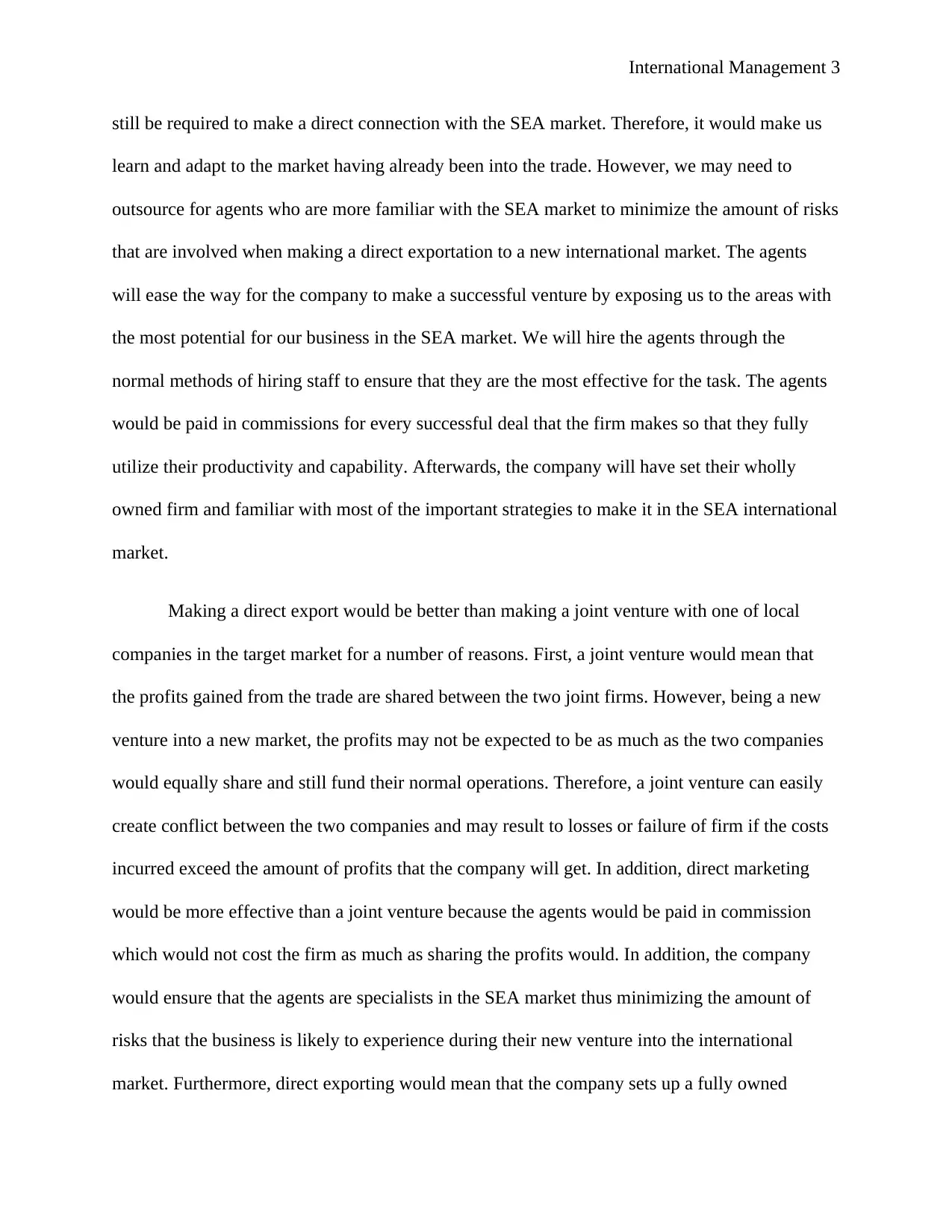
International Management 3
still be required to make a direct connection with the SEA market. Therefore, it would make us
learn and adapt to the market having already been into the trade. However, we may need to
outsource for agents who are more familiar with the SEA market to minimize the amount of risks
that are involved when making a direct exportation to a new international market. The agents
will ease the way for the company to make a successful venture by exposing us to the areas with
the most potential for our business in the SEA market. We will hire the agents through the
normal methods of hiring staff to ensure that they are the most effective for the task. The agents
would be paid in commissions for every successful deal that the firm makes so that they fully
utilize their productivity and capability. Afterwards, the company will have set their wholly
owned firm and familiar with most of the important strategies to make it in the SEA international
market.
Making a direct export would be better than making a joint venture with one of local
companies in the target market for a number of reasons. First, a joint venture would mean that
the profits gained from the trade are shared between the two joint firms. However, being a new
venture into a new market, the profits may not be expected to be as much as the two companies
would equally share and still fund their normal operations. Therefore, a joint venture can easily
create conflict between the two companies and may result to losses or failure of firm if the costs
incurred exceed the amount of profits that the company will get. In addition, direct marketing
would be more effective than a joint venture because the agents would be paid in commission
which would not cost the firm as much as sharing the profits would. In addition, the company
would ensure that the agents are specialists in the SEA market thus minimizing the amount of
risks that the business is likely to experience during their new venture into the international
market. Furthermore, direct exporting would mean that the company sets up a fully owned
still be required to make a direct connection with the SEA market. Therefore, it would make us
learn and adapt to the market having already been into the trade. However, we may need to
outsource for agents who are more familiar with the SEA market to minimize the amount of risks
that are involved when making a direct exportation to a new international market. The agents
will ease the way for the company to make a successful venture by exposing us to the areas with
the most potential for our business in the SEA market. We will hire the agents through the
normal methods of hiring staff to ensure that they are the most effective for the task. The agents
would be paid in commissions for every successful deal that the firm makes so that they fully
utilize their productivity and capability. Afterwards, the company will have set their wholly
owned firm and familiar with most of the important strategies to make it in the SEA international
market.
Making a direct export would be better than making a joint venture with one of local
companies in the target market for a number of reasons. First, a joint venture would mean that
the profits gained from the trade are shared between the two joint firms. However, being a new
venture into a new market, the profits may not be expected to be as much as the two companies
would equally share and still fund their normal operations. Therefore, a joint venture can easily
create conflict between the two companies and may result to losses or failure of firm if the costs
incurred exceed the amount of profits that the company will get. In addition, direct marketing
would be more effective than a joint venture because the agents would be paid in commission
which would not cost the firm as much as sharing the profits would. In addition, the company
would ensure that the agents are specialists in the SEA market thus minimizing the amount of
risks that the business is likely to experience during their new venture into the international
market. Furthermore, direct exporting would mean that the company sets up a fully owned
⊘ This is a preview!⊘
Do you want full access?
Subscribe today to unlock all pages.

Trusted by 1+ million students worldwide
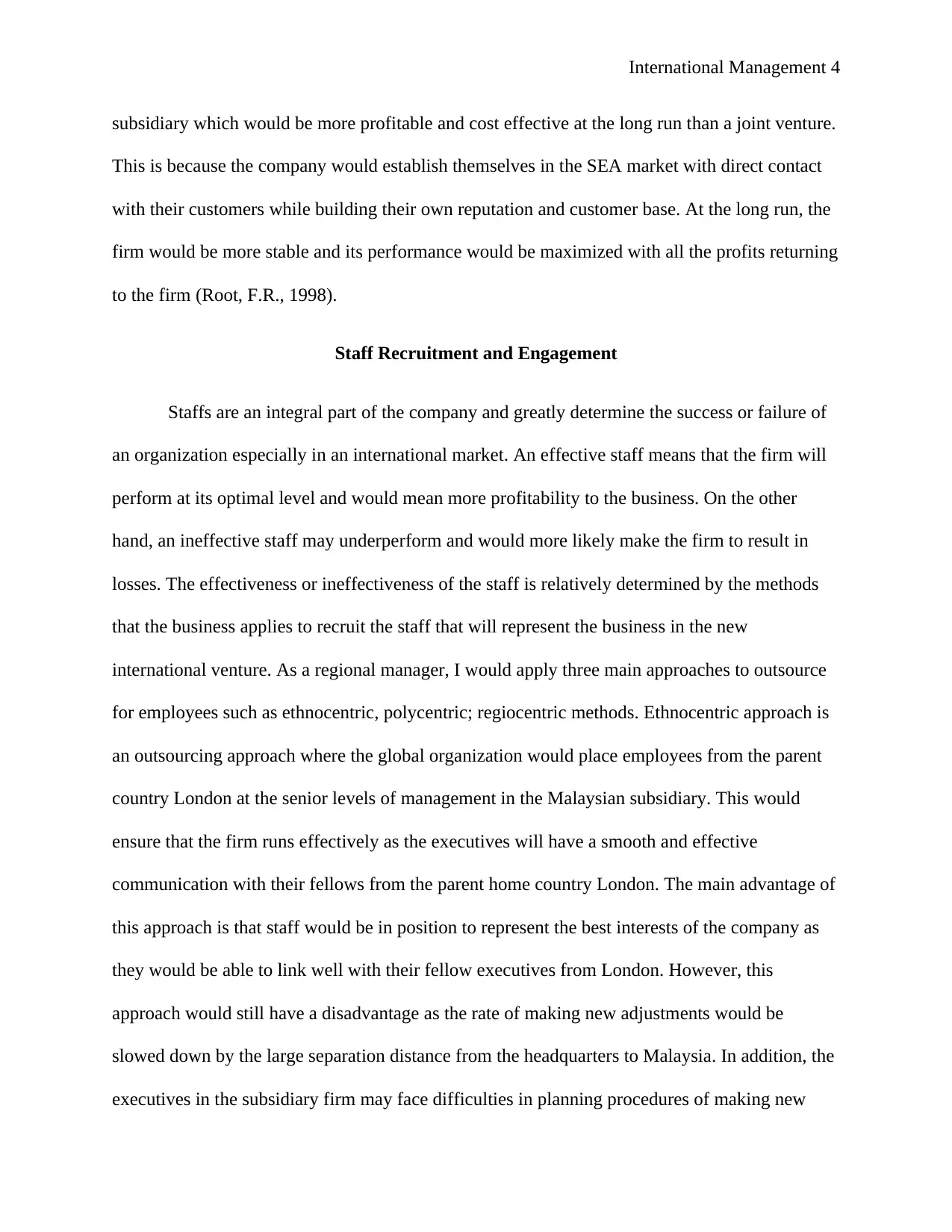
International Management 4
subsidiary which would be more profitable and cost effective at the long run than a joint venture.
This is because the company would establish themselves in the SEA market with direct contact
with their customers while building their own reputation and customer base. At the long run, the
firm would be more stable and its performance would be maximized with all the profits returning
to the firm (Root, F.R., 1998).
Staff Recruitment and Engagement
Staffs are an integral part of the company and greatly determine the success or failure of
an organization especially in an international market. An effective staff means that the firm will
perform at its optimal level and would mean more profitability to the business. On the other
hand, an ineffective staff may underperform and would more likely make the firm to result in
losses. The effectiveness or ineffectiveness of the staff is relatively determined by the methods
that the business applies to recruit the staff that will represent the business in the new
international venture. As a regional manager, I would apply three main approaches to outsource
for employees such as ethnocentric, polycentric; regiocentric methods. Ethnocentric approach is
an outsourcing approach where the global organization would place employees from the parent
country London at the senior levels of management in the Malaysian subsidiary. This would
ensure that the firm runs effectively as the executives will have a smooth and effective
communication with their fellows from the parent home country London. The main advantage of
this approach is that staff would be in position to represent the best interests of the company as
they would be able to link well with their fellow executives from London. However, this
approach would still have a disadvantage as the rate of making new adjustments would be
slowed down by the large separation distance from the headquarters to Malaysia. In addition, the
executives in the subsidiary firm may face difficulties in planning procedures of making new
subsidiary which would be more profitable and cost effective at the long run than a joint venture.
This is because the company would establish themselves in the SEA market with direct contact
with their customers while building their own reputation and customer base. At the long run, the
firm would be more stable and its performance would be maximized with all the profits returning
to the firm (Root, F.R., 1998).
Staff Recruitment and Engagement
Staffs are an integral part of the company and greatly determine the success or failure of
an organization especially in an international market. An effective staff means that the firm will
perform at its optimal level and would mean more profitability to the business. On the other
hand, an ineffective staff may underperform and would more likely make the firm to result in
losses. The effectiveness or ineffectiveness of the staff is relatively determined by the methods
that the business applies to recruit the staff that will represent the business in the new
international venture. As a regional manager, I would apply three main approaches to outsource
for employees such as ethnocentric, polycentric; regiocentric methods. Ethnocentric approach is
an outsourcing approach where the global organization would place employees from the parent
country London at the senior levels of management in the Malaysian subsidiary. This would
ensure that the firm runs effectively as the executives will have a smooth and effective
communication with their fellows from the parent home country London. The main advantage of
this approach is that staff would be in position to represent the best interests of the company as
they would be able to link well with their fellow executives from London. However, this
approach would still have a disadvantage as the rate of making new adjustments would be
slowed down by the large separation distance from the headquarters to Malaysia. In addition, the
executives in the subsidiary firm may face difficulties in planning procedures of making new
Paraphrase This Document
Need a fresh take? Get an instant paraphrase of this document with our AI Paraphraser
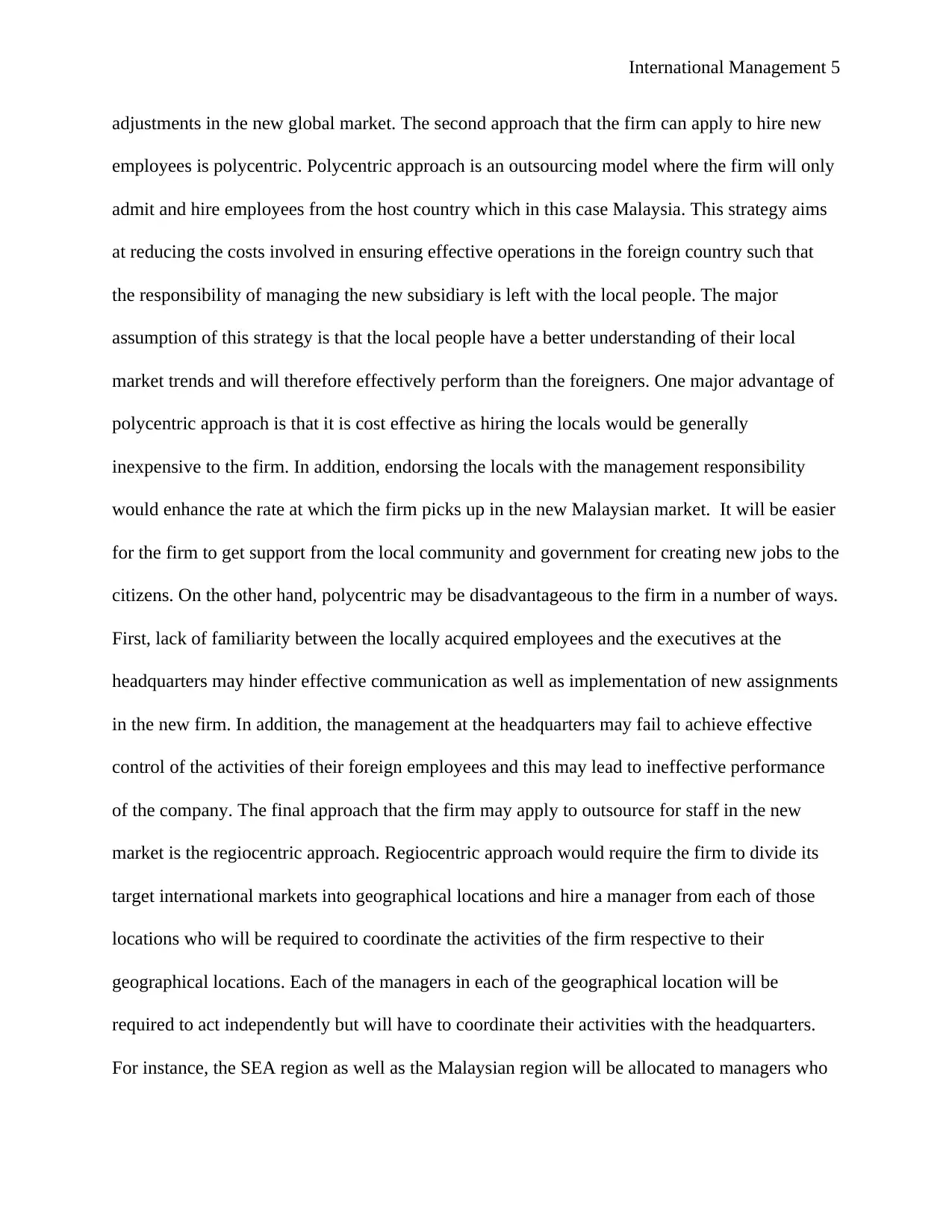
International Management 5
adjustments in the new global market. The second approach that the firm can apply to hire new
employees is polycentric. Polycentric approach is an outsourcing model where the firm will only
admit and hire employees from the host country which in this case Malaysia. This strategy aims
at reducing the costs involved in ensuring effective operations in the foreign country such that
the responsibility of managing the new subsidiary is left with the local people. The major
assumption of this strategy is that the local people have a better understanding of their local
market trends and will therefore effectively perform than the foreigners. One major advantage of
polycentric approach is that it is cost effective as hiring the locals would be generally
inexpensive to the firm. In addition, endorsing the locals with the management responsibility
would enhance the rate at which the firm picks up in the new Malaysian market. It will be easier
for the firm to get support from the local community and government for creating new jobs to the
citizens. On the other hand, polycentric may be disadvantageous to the firm in a number of ways.
First, lack of familiarity between the locally acquired employees and the executives at the
headquarters may hinder effective communication as well as implementation of new assignments
in the new firm. In addition, the management at the headquarters may fail to achieve effective
control of the activities of their foreign employees and this may lead to ineffective performance
of the company. The final approach that the firm may apply to outsource for staff in the new
market is the regiocentric approach. Regiocentric approach would require the firm to divide its
target international markets into geographical locations and hire a manager from each of those
locations who will be required to coordinate the activities of the firm respective to their
geographical locations. Each of the managers in each of the geographical location will be
required to act independently but will have to coordinate their activities with the headquarters.
For instance, the SEA region as well as the Malaysian region will be allocated to managers who
adjustments in the new global market. The second approach that the firm can apply to hire new
employees is polycentric. Polycentric approach is an outsourcing model where the firm will only
admit and hire employees from the host country which in this case Malaysia. This strategy aims
at reducing the costs involved in ensuring effective operations in the foreign country such that
the responsibility of managing the new subsidiary is left with the local people. The major
assumption of this strategy is that the local people have a better understanding of their local
market trends and will therefore effectively perform than the foreigners. One major advantage of
polycentric approach is that it is cost effective as hiring the locals would be generally
inexpensive to the firm. In addition, endorsing the locals with the management responsibility
would enhance the rate at which the firm picks up in the new Malaysian market. It will be easier
for the firm to get support from the local community and government for creating new jobs to the
citizens. On the other hand, polycentric may be disadvantageous to the firm in a number of ways.
First, lack of familiarity between the locally acquired employees and the executives at the
headquarters may hinder effective communication as well as implementation of new assignments
in the new firm. In addition, the management at the headquarters may fail to achieve effective
control of the activities of their foreign employees and this may lead to ineffective performance
of the company. The final approach that the firm may apply to outsource for staff in the new
market is the regiocentric approach. Regiocentric approach would require the firm to divide its
target international markets into geographical locations and hire a manager from each of those
locations who will be required to coordinate the activities of the firm respective to their
geographical locations. Each of the managers in each of the geographical location will be
required to act independently but will have to coordinate their activities with the headquarters.
For instance, the SEA region as well as the Malaysian region will be allocated to managers who
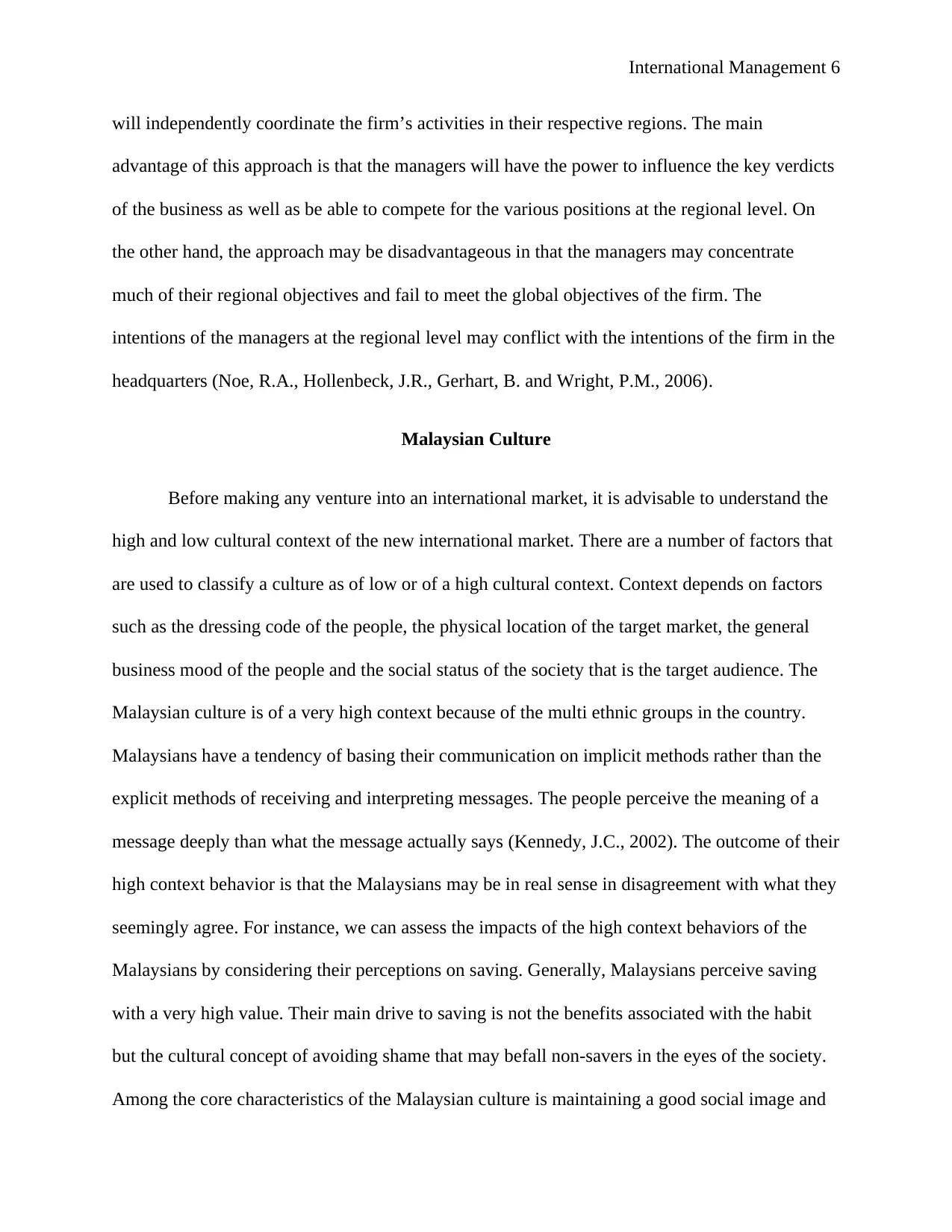
International Management 6
will independently coordinate the firm’s activities in their respective regions. The main
advantage of this approach is that the managers will have the power to influence the key verdicts
of the business as well as be able to compete for the various positions at the regional level. On
the other hand, the approach may be disadvantageous in that the managers may concentrate
much of their regional objectives and fail to meet the global objectives of the firm. The
intentions of the managers at the regional level may conflict with the intentions of the firm in the
headquarters (Noe, R.A., Hollenbeck, J.R., Gerhart, B. and Wright, P.M., 2006).
Malaysian Culture
Before making any venture into an international market, it is advisable to understand the
high and low cultural context of the new international market. There are a number of factors that
are used to classify a culture as of low or of a high cultural context. Context depends on factors
such as the dressing code of the people, the physical location of the target market, the general
business mood of the people and the social status of the society that is the target audience. The
Malaysian culture is of a very high context because of the multi ethnic groups in the country.
Malaysians have a tendency of basing their communication on implicit methods rather than the
explicit methods of receiving and interpreting messages. The people perceive the meaning of a
message deeply than what the message actually says (Kennedy, J.C., 2002). The outcome of their
high context behavior is that the Malaysians may be in real sense in disagreement with what they
seemingly agree. For instance, we can assess the impacts of the high context behaviors of the
Malaysians by considering their perceptions on saving. Generally, Malaysians perceive saving
with a very high value. Their main drive to saving is not the benefits associated with the habit
but the cultural concept of avoiding shame that may befall non-savers in the eyes of the society.
Among the core characteristics of the Malaysian culture is maintaining a good social image and
will independently coordinate the firm’s activities in their respective regions. The main
advantage of this approach is that the managers will have the power to influence the key verdicts
of the business as well as be able to compete for the various positions at the regional level. On
the other hand, the approach may be disadvantageous in that the managers may concentrate
much of their regional objectives and fail to meet the global objectives of the firm. The
intentions of the managers at the regional level may conflict with the intentions of the firm in the
headquarters (Noe, R.A., Hollenbeck, J.R., Gerhart, B. and Wright, P.M., 2006).
Malaysian Culture
Before making any venture into an international market, it is advisable to understand the
high and low cultural context of the new international market. There are a number of factors that
are used to classify a culture as of low or of a high cultural context. Context depends on factors
such as the dressing code of the people, the physical location of the target market, the general
business mood of the people and the social status of the society that is the target audience. The
Malaysian culture is of a very high context because of the multi ethnic groups in the country.
Malaysians have a tendency of basing their communication on implicit methods rather than the
explicit methods of receiving and interpreting messages. The people perceive the meaning of a
message deeply than what the message actually says (Kennedy, J.C., 2002). The outcome of their
high context behavior is that the Malaysians may be in real sense in disagreement with what they
seemingly agree. For instance, we can assess the impacts of the high context behaviors of the
Malaysians by considering their perceptions on saving. Generally, Malaysians perceive saving
with a very high value. Their main drive to saving is not the benefits associated with the habit
but the cultural concept of avoiding shame that may befall non-savers in the eyes of the society.
Among the core characteristics of the Malaysian culture is maintaining a good social image and
⊘ This is a preview!⊘
Do you want full access?
Subscribe today to unlock all pages.

Trusted by 1+ million students worldwide
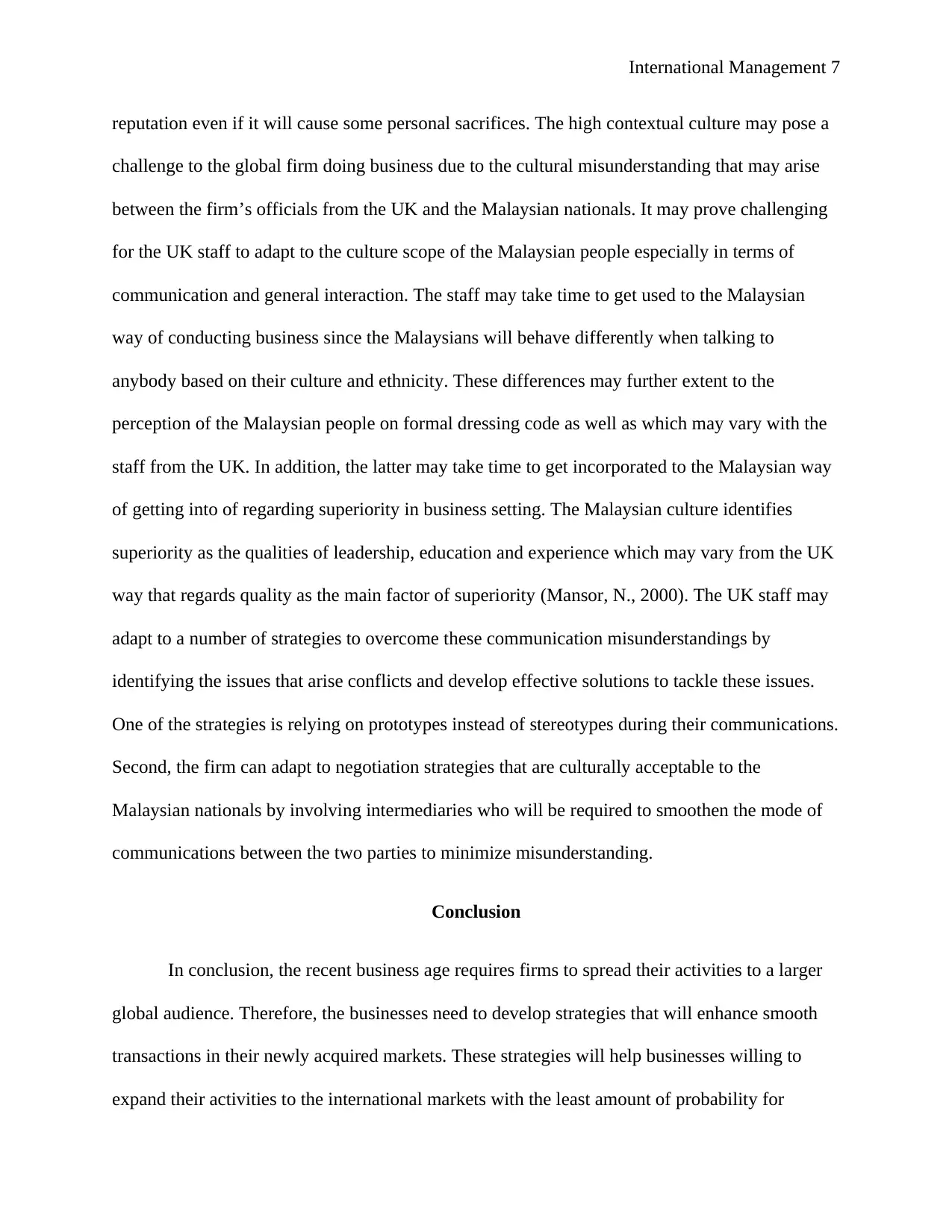
International Management 7
reputation even if it will cause some personal sacrifices. The high contextual culture may pose a
challenge to the global firm doing business due to the cultural misunderstanding that may arise
between the firm’s officials from the UK and the Malaysian nationals. It may prove challenging
for the UK staff to adapt to the culture scope of the Malaysian people especially in terms of
communication and general interaction. The staff may take time to get used to the Malaysian
way of conducting business since the Malaysians will behave differently when talking to
anybody based on their culture and ethnicity. These differences may further extent to the
perception of the Malaysian people on formal dressing code as well as which may vary with the
staff from the UK. In addition, the latter may take time to get incorporated to the Malaysian way
of getting into of regarding superiority in business setting. The Malaysian culture identifies
superiority as the qualities of leadership, education and experience which may vary from the UK
way that regards quality as the main factor of superiority (Mansor, N., 2000). The UK staff may
adapt to a number of strategies to overcome these communication misunderstandings by
identifying the issues that arise conflicts and develop effective solutions to tackle these issues.
One of the strategies is relying on prototypes instead of stereotypes during their communications.
Second, the firm can adapt to negotiation strategies that are culturally acceptable to the
Malaysian nationals by involving intermediaries who will be required to smoothen the mode of
communications between the two parties to minimize misunderstanding.
Conclusion
In conclusion, the recent business age requires firms to spread their activities to a larger
global audience. Therefore, the businesses need to develop strategies that will enhance smooth
transactions in their newly acquired markets. These strategies will help businesses willing to
expand their activities to the international markets with the least amount of probability for
reputation even if it will cause some personal sacrifices. The high contextual culture may pose a
challenge to the global firm doing business due to the cultural misunderstanding that may arise
between the firm’s officials from the UK and the Malaysian nationals. It may prove challenging
for the UK staff to adapt to the culture scope of the Malaysian people especially in terms of
communication and general interaction. The staff may take time to get used to the Malaysian
way of conducting business since the Malaysians will behave differently when talking to
anybody based on their culture and ethnicity. These differences may further extent to the
perception of the Malaysian people on formal dressing code as well as which may vary with the
staff from the UK. In addition, the latter may take time to get incorporated to the Malaysian way
of getting into of regarding superiority in business setting. The Malaysian culture identifies
superiority as the qualities of leadership, education and experience which may vary from the UK
way that regards quality as the main factor of superiority (Mansor, N., 2000). The UK staff may
adapt to a number of strategies to overcome these communication misunderstandings by
identifying the issues that arise conflicts and develop effective solutions to tackle these issues.
One of the strategies is relying on prototypes instead of stereotypes during their communications.
Second, the firm can adapt to negotiation strategies that are culturally acceptable to the
Malaysian nationals by involving intermediaries who will be required to smoothen the mode of
communications between the two parties to minimize misunderstanding.
Conclusion
In conclusion, the recent business age requires firms to spread their activities to a larger
global audience. Therefore, the businesses need to develop strategies that will enhance smooth
transactions in their newly acquired markets. These strategies will help businesses willing to
expand their activities to the international markets with the least amount of probability for
Paraphrase This Document
Need a fresh take? Get an instant paraphrase of this document with our AI Paraphraser
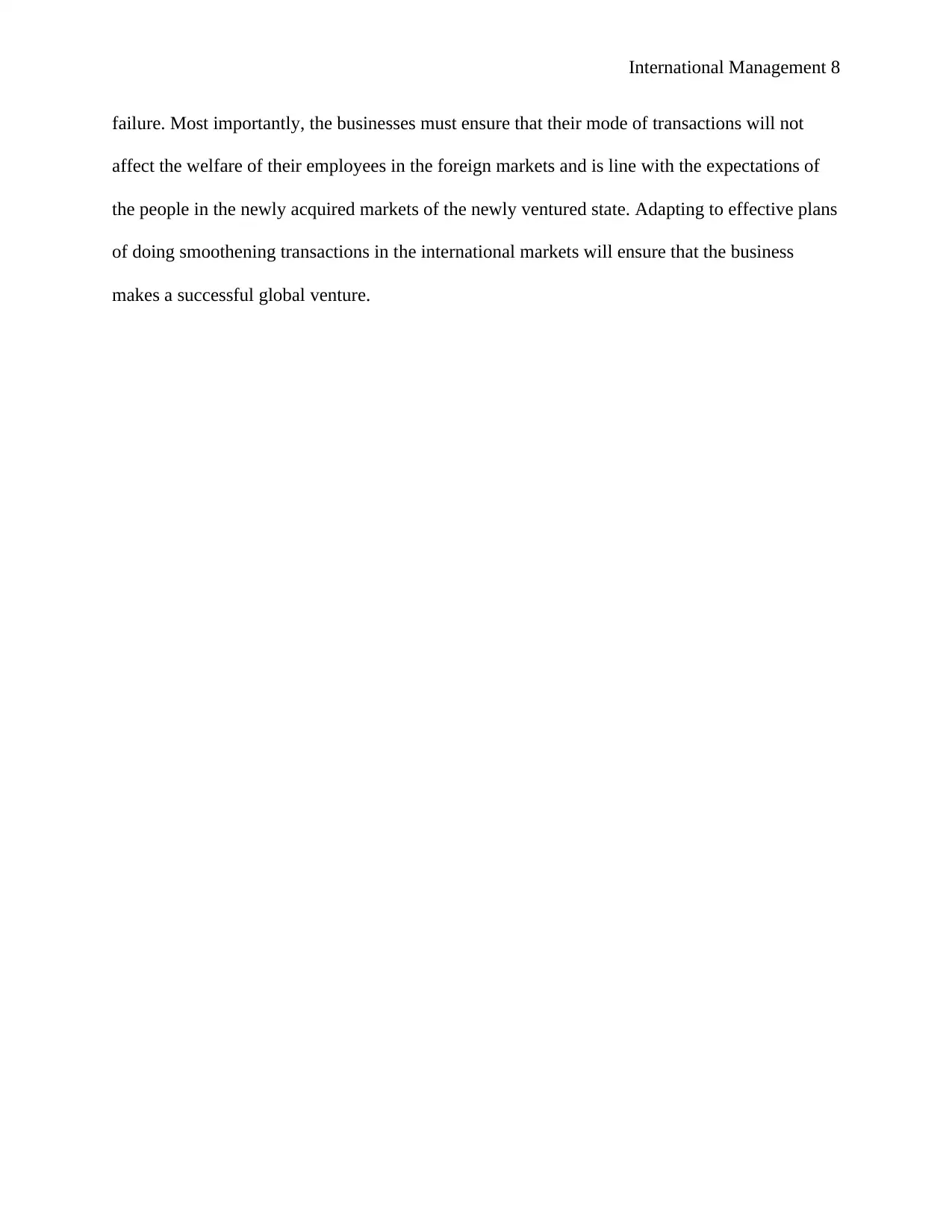
International Management 8
failure. Most importantly, the businesses must ensure that their mode of transactions will not
affect the welfare of their employees in the foreign markets and is line with the expectations of
the people in the newly acquired markets of the newly ventured state. Adapting to effective plans
of doing smoothening transactions in the international markets will ensure that the business
makes a successful global venture.
failure. Most importantly, the businesses must ensure that their mode of transactions will not
affect the welfare of their employees in the foreign markets and is line with the expectations of
the people in the newly acquired markets of the newly ventured state. Adapting to effective plans
of doing smoothening transactions in the international markets will ensure that the business
makes a successful global venture.
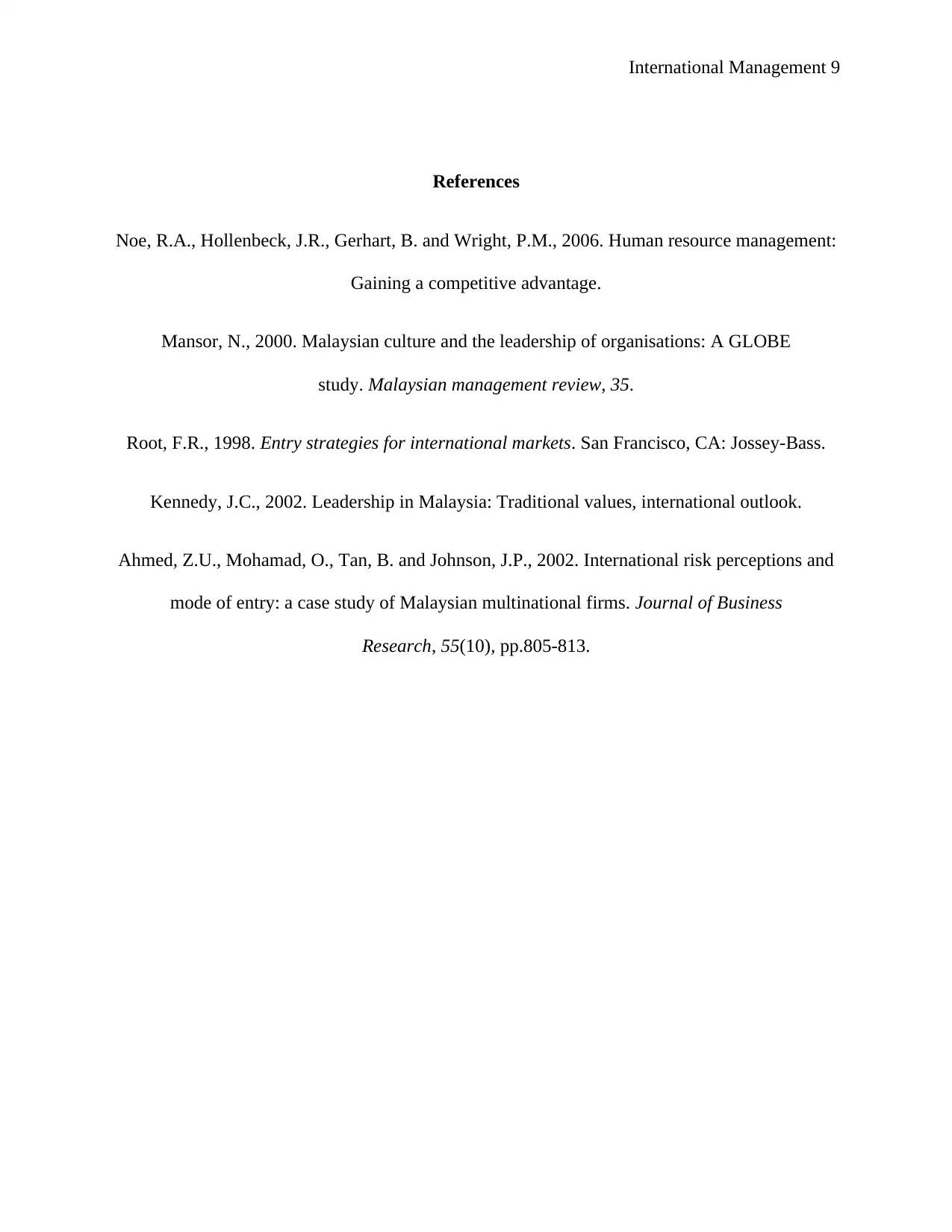
International Management 9
References
Noe, R.A., Hollenbeck, J.R., Gerhart, B. and Wright, P.M., 2006. Human resource management:
Gaining a competitive advantage.
Mansor, N., 2000. Malaysian culture and the leadership of organisations: A GLOBE
study. Malaysian management review, 35.
Root, F.R., 1998. Entry strategies for international markets. San Francisco, CA: Jossey-Bass.
Kennedy, J.C., 2002. Leadership in Malaysia: Traditional values, international outlook.
Ahmed, Z.U., Mohamad, O., Tan, B. and Johnson, J.P., 2002. International risk perceptions and
mode of entry: a case study of Malaysian multinational firms. Journal of Business
Research, 55(10), pp.805-813.
References
Noe, R.A., Hollenbeck, J.R., Gerhart, B. and Wright, P.M., 2006. Human resource management:
Gaining a competitive advantage.
Mansor, N., 2000. Malaysian culture and the leadership of organisations: A GLOBE
study. Malaysian management review, 35.
Root, F.R., 1998. Entry strategies for international markets. San Francisco, CA: Jossey-Bass.
Kennedy, J.C., 2002. Leadership in Malaysia: Traditional values, international outlook.
Ahmed, Z.U., Mohamad, O., Tan, B. and Johnson, J.P., 2002. International risk perceptions and
mode of entry: a case study of Malaysian multinational firms. Journal of Business
Research, 55(10), pp.805-813.
⊘ This is a preview!⊘
Do you want full access?
Subscribe today to unlock all pages.

Trusted by 1+ million students worldwide
1 out of 9
Related Documents
Your All-in-One AI-Powered Toolkit for Academic Success.
+13062052269
info@desklib.com
Available 24*7 on WhatsApp / Email
![[object Object]](/_next/static/media/star-bottom.7253800d.svg)
Unlock your academic potential
Copyright © 2020–2025 A2Z Services. All Rights Reserved. Developed and managed by ZUCOL.





